Application of Polymeric Tubular Ultrafiltration Membranes for Separation of Car Wash Wastewater
Abstract
:1. Introduction
2. Materials and Methods
2.1. UF Procedure
2.2. Solutions Composition
2.3. Analytical Methods
3. Results
3.1. Membrane Performance
3.2. UF Separation of Synthetic Wastewaters
3.3. Ultrafiltration of Real Wastewater
3.4. Membrane Fouling
4. Conclusions
Author Contributions
Funding
Institutional Review Board Statement
Data Availability Statement
Conflicts of Interest
Appendix A
| Parameter [mg/L] | Feed | Feed-F 1 | Permeate | Retentate | Retentate-F 1 | Permeate R2 |
|---|---|---|---|---|---|---|
| FP100-WW1 | ||||||
| COD | 1026 | 800 | 724 | 2257 | 1508 | 721 |
| BOD | 368 | 344 | 103 | 362 | 345 | 112 |
| anionic | 130 | 133 | 72 | 305 | 260 | 81 |
| P total | 14.4 | 12.8 | 6.6 | 32.1 | 27.5 | 7.5 |
| N total | 12.5 | 7.2 | 7.5 | 27.4 | 17.8 | 6.7 |
| FP200-WW2 | ||||||
| COD | 998 | 637 | 515 | 1644 | 816 | 525 |
| BOD | 68 | 15 | 12 | 79 | 18 | 12 |
| anionic | 92.5 | 56 | 33.2 | 264 | 89 | 38 |
| nonionic | 10.4 | 4.1 | 2.4 | 31.2 | 8.8 | 3.4 |
| P total | 7.6 | 7.4 | 5.2 | 14.2 | 10.2 | 6.1 |
| N total | 7.6 | 5.1 | 4.8 | 14.4 | 10.7 | 7.0 |
| ESP04-WW2 | ||||||
| COD | 775 | 689 | 304 | 1346 | 788 | 324 |
| BOD | 266 | 60 | 55 | 486 | 65 | 60 |
| anionic | 106 | 70.6 | 31 | 177 | 81.7 | 31.2 |
| nonionic | 13.5 | 6.4 | 3.4 | 16.8 | 12.3 | 5.7 |
| P total | 12.8 | 11.3 | 5.6 | 21.7 | 13.8 | 6.3 |
| N total | 8.5 | 6.4 | 3.9 | 16.6 | 10.1 | 4.6 |
Appendix B
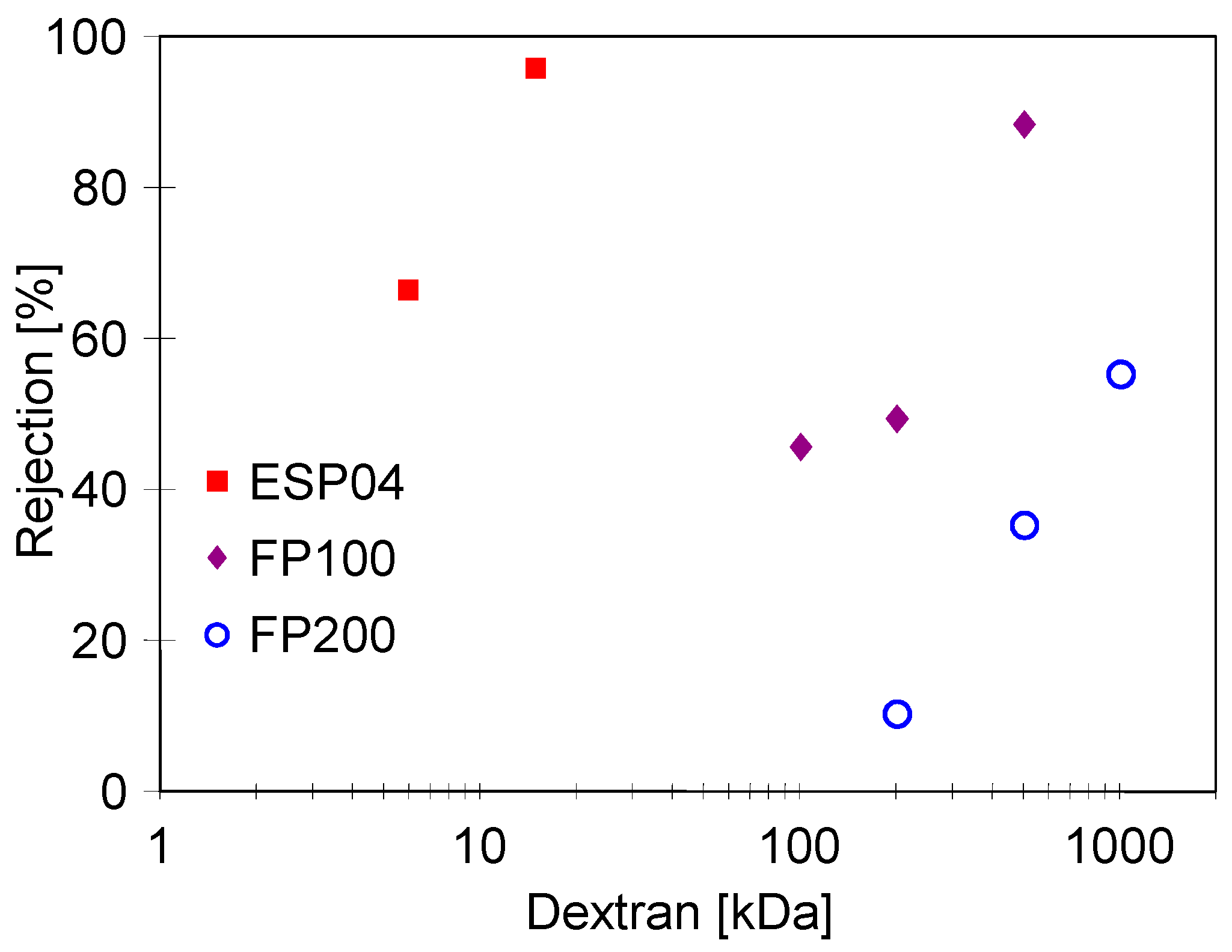

References
- Janik, H.; Kupiec, A. Trends in Modern Car Washing. Pol. J. Environ. Stud. 2007, 16, 927–931. [Google Scholar]
- Zielińska, E. The role and importance car washes in Poland. Autobusy 2016, 12, 520–523. [Google Scholar]
- Singh, P.; Berawala, N.; Patil, Y. Automobile service station waste assessment and promising biological treatment alternatives: A review. Environ. Monit. Assess. 2022, 194, 753. [Google Scholar] [CrossRef]
- Boluarte, I.A.R.; Andersen, M.; Pramanik, B.K.; Chang, C.Y.; Bagshaw, S.; Farago, L.; Shu, L. Reuse of car wash wastewater by chemical coagulation and membrane bioreactor treatment processes. Int. Biodeterior. Biodegrad. 2016, 113, 44–48. [Google Scholar] [CrossRef]
- Boussu, K.; Van Baelen, G.; Colen, W.; Eelen, D.; Vanassche, S.; Vandecasteele, C.; Van der Bruggen, B. Technical and economical evaluation of water recycling in the carwash industry with membrane processes. Water Sci. Technol. 2008, 57, 1131–1135. [Google Scholar] [CrossRef]
- Gönder, Z.B.; Balcıoğlu, G.; Vergili, I.; Kaya, Y. Electrochemical treatment of carwash wastewater using Fe and Al electrode: Techno-economic analysis and sludge characterization. J. Environ. Manag. 2017, 200, 380–390. [Google Scholar] [CrossRef]
- Fayed, M.; Shewitah, M.A.; Dupont, R.R.; Fayed, M.; Badr, M.M. Treatability study of car wash wastewater using upgraded physical technique with sustainable flocculant. Sustainability 2023, 15, 8581. [Google Scholar] [CrossRef]
- Kashi, G.; Younesi, S.; Heidary, A.; Akbarishahabi, Z.; Kavianpour, B.; Kalantary, R.R. Carwash wastewater treatment using the chemical processes. Water Sci. Technol. 2021, 84, 16–26. [Google Scholar] [CrossRef]
- Ardic, S.; Altun, I.; Peker, G.; Kose, B. Can water lacerate a tendon? A car-wash accident: A lacerated extensor hallucis longus tendon. Turk. J. Emerg. Med. 2018, 18, 137–138. [Google Scholar] [CrossRef]
- Sarmadi, M.; Foroughi, M.; Saleh, H.N.; Sanaei, D.; Zarei, A.A.; Ghahrchi, M.; Bazrafshan, E. Efficient technologies for carwash wastewater treatment: A systematic review. Environ. Sci. Pollut. Res. 2020, 27, 34823–34839. [Google Scholar] [CrossRef]
- Lin, P.-H.; Su, Y.-C.; Chen, C.-L.; Tsao, I.-Y. Characterization of fouled ultrafiltration membranes from a full-scale wastewater reclamation plant in iron and steel industry. Int. J. Environ. Sci. Technol. 2023, 20, 11501–11512. [Google Scholar] [CrossRef]
- Siagian, U.W.R.; Khoiruddin, K.; Wardani, A.K.; Aryanti, P.T.P.; Widiasa, I.N.; Guanglei Qiu, G.; Ting, Y.P.; Wenten, I.G. High-Performance Ultrafiltration Membrane: Recent Progress and Its Application for Wastewater Treatment. Curr. Pollut. Rep. 2021, 7, 448–462. [Google Scholar] [CrossRef]
- Lau, W.J.; Ismail, A.F.; Firdaus, S. Car wash industry in Malaysia: Treatment of car wash effluent using ultrafiltration and nanofiltration membranes. Sep. Purif. Technol. 2013, 104, 26–31. [Google Scholar] [CrossRef]
- Moazzem, S.; Wills, J.; Fan, L.; Roddick, F.; Jegatheesan, V. Performance of ceramic ultrafiltration and reverse osmosis membranes in treating car wash wastewater for reuse. Environ. Sci. Pollut. Res. 2018, 25, 8654–8668. [Google Scholar] [CrossRef] [PubMed]
- Gryta, M.; Woźniak, P. Polyethersulfone membrane fouling mitigation during ultrafiltration of wastewaters from car washes. Desalination 2024, 574, 117254. [Google Scholar] [CrossRef]
- Li, J.-X.; Sanderson, R.D.; Chai, G.Y. A focused ultrasonic sensor for in situ detection of protein fouling on tubular ultrafiltration membranes. Sens. Actuators. B 2006, 114, 182–191. [Google Scholar] [CrossRef]
- Nilusha, R.T.; Wei, Y. New Insights into the Microbial Diversity of Cake Layer in Yttria Composite Ceramic Tubular Membrane in an Anaerobic Membrane Bioreactor (AnMBR). Membranes 2021, 11, 108. [Google Scholar] [CrossRef]
- Trusek, A.; Wajsprych, M.; Noworyta, A. Low- and High-Pressure Membrane Separation in the Production of Process Water for Coke Quenching. Membranes 2021, 11, 937. [Google Scholar] [CrossRef]
- Gryta, M.; Wożniak, P. The Resistance of Polyethersulfone Membranes on the Alkaline Cleaning Solutions. Membranes 2024, 14, 27. [Google Scholar] [CrossRef]
- Shehnaz, H.; Aziz, A.; Ismail, A.; Haider, A.; Lahori, A.H. Impact assessment of automobile service stations effluent of karachi city. FUUAST J. Biol. 2022, 12, 23–27. [Google Scholar]
- Tomczak, W.; Gryta, M. Comparison of Polypropylene and Ceramic Microfiltration Membranes Applied for Separation of 1,3-PD Fermentation Broths and Saccharomyces cerevisiae Yeast Suspensions. Membranes 2021, 11, 44. [Google Scholar] [CrossRef] [PubMed]
- Tofighy, M.A.; Mohammadi, T. Functional charcoal based nanomaterial with excellent colloidal property for fabrication of polyethersulfone ultrafiltration membrane with improved flux and fouling resistance. Mater. Chem. Phys. 2022, 285, 126167–126181. [Google Scholar] [CrossRef]
- Mishra, J.R.; Samal, S.K.; Mohanty, S.; Nayak, S.K. Polyvinylidene fluoride (PVDF)/Ag@TiO2 nanocomposite membrane with enhanced fouling resistance and antibacterial performance. Mater. Chem. Phys. 2021, 268, 124723–124735. [Google Scholar] [CrossRef]
- Zhu, J.; Zhou, S.; Li, M.; Xue, A.; Zhao, Y.; Peng, W.; Xing, W. PVDF mixed matrix ultrafiltration membrane incorporated with deformed rebar-like Fe3O4–palygorskite nanocomposites to enhance strength and antifouling properties. J. Membr. Sci. 2020, 612, 118467–118479. [Google Scholar] [CrossRef]
- Ren, L.; Deng, R.; Yang, J.; Li, J.; Jin, J.; Lei, T. Improved hydrophilicity and antifouling performances of PVDF ultrafiltration membrane via in situ cross-linking. J. Mater. Sci. 2023, 58, 13854–13864. [Google Scholar] [CrossRef]
- Chheang, M.; Hongprasith, N.; Ratanatawanate, C.; Lohwacharin, J. Effects of Chemical Cleaning on the Ageing of Polyvinylidene Fluoride Microfiltration and Ultrafiltration Membranes Fouled with Organic and Inorganic Matter. Membranes 2022, 12, 280. [Google Scholar] [CrossRef] [PubMed]
- Ji, M.; Luo, J.; Wei, J.; Woodley, J.; Daugaard, A.E.; Pinelo, M. Commercial Polysulfone Membranes Pretreated with Ethanol and NaOH: Effects on Permeability, Selectivity and Antifouling Properties. Sep. Purif. Technol. 2019, 219, 82–89. [Google Scholar] [CrossRef]
- Ezazi, M.; Quazi, M.M. Recent Developments in Two-Dimensional Materials-Based Membranes for Oil–Water Separation. Membranes 2023, 13, 677. [Google Scholar] [CrossRef]
- Song, S.; Sun, H.; Xia, J.; Bao, S.; Ding, W.; Liu, N.; Wang, T.; Sui, K.; Gao, J.; Liu, X.; et al. Spontaneous and rapid electrostatic solvent nanofiltration based on a conductive layered membrane. Inorg. Chem. Front. 2024, 11, 5876–5883. [Google Scholar] [CrossRef]
- Uçar, D. Membrane processes for the reuse of car washing wastewater. J. Water Reuse Desalination 2018, 8, 169–175. [Google Scholar] [CrossRef]
- PCI Membranes, Product & Technical Showcase. Available online: https://www.thembrsite.com/uploads/documents/pdf_PCI_Brochure.pdf (accessed on 10 September 2024).
- Karakulski, K.; Gryta, M. The Application of Ultrafiltration for Treatment of Ships Generated Oily Wastewater. Chem. Pap. 2017, 71, 1165–1173. [Google Scholar] [CrossRef]
- Salud Camilleri-Rumbau, M.; Popovic, O.; Briceño, K.; Errico, M.; Søtoft, L.F.; Christensen, K.V.; Norddahl, B. Ultrafiltration of Separated Digestate by Tubular Membranes: Influence of Feed Pretreatment on Hydraulic Performance and Heavy Metals Removal. J. Environ. Manag. 2019, 250, 109404. [Google Scholar] [CrossRef] [PubMed]
- Abdel-Karim, A.; Gad-Allah, T.A.; El-Kalliny, A.S.; Ahmed, S.I.A.; Souaya, E.R.; Badawy, M.I.; Ulbricht, M. Fabrication of modified polyethersulfone membranes for wastewater treatment by submerged membrane bioreactor. Sep. Purif. Technol. 2017, 175, 36–46. [Google Scholar] [CrossRef]
- Kowalska, I.; Kabsch-Korbutowicz, M.; Majewska-Nowak, K.; Winnicki, T. Separation of anionic surfactants on ultrafiltration membranes. Desalination 2004, 162, 33–40. [Google Scholar] [CrossRef]
- Tomczak, W. The Application of the Nanofiltration Membrane NF270 for Separation of Fermentation Broths. Membranes 2022, 12, 1263. [Google Scholar] [CrossRef]
- Xiarchos, I.; Doulia, D.; Gekas, V.; Trägårdh, G. Polymeric ultrafiltration membranes and surfactants. Sep. Purif. Rev. 2003, 32, 215–278. [Google Scholar] [CrossRef]
- Antón, E.; Álvarez, J.R.; Palacio, L.; Prádanos, P.; Hernández, A.; Pihlajamäki, A.; Luque, S. Ageing of Polyethersulfone Ultrafiltration Membranes Under Long-Term Exposures to Alkaline and Acidic Cleaning Solutions. Chem. Eng. Sci. 2015, 134, 178–195. [Google Scholar] [CrossRef]
- Niazmand, R.; Razavi, S.M.A.; Farhoosh, R. Colloid-enhanced ultrafiltration of canola oil: Effect of process conditions and MECO on flux, fouling and rejections. J. Food Process. Preserv. 2015, 39, 292–300. [Google Scholar] [CrossRef]
- Jönsson, C.; Jönsson, A.S. The influence of degreasing agents used at car washes on the performance of ultrafiltration membranes. Desalination 1995, 100, 115–123. [Google Scholar] [CrossRef]
- Qu, F.; Liang, H.; Zhou, J.; Nan, J.; Shao, S.; Zhang, J.; Li, G. Ultrafiltration membrane fouling caused by extracellular organic matter (EOM) from Microcystis aeruginosa: Effects of membrane pore size and surface hydrophobicity. J. Membr. Sci. 2014, 449, 58–66. [Google Scholar] [CrossRef]
- Zhang, X.; Li, F.; Zhao, X. Treatment of surfactants with concentrations below critical micelle concentration by ultrafiltration: A mini-review. Water Cycle 2022, 3, 50–55. [Google Scholar] [CrossRef]
- Tomczak, W.; Gryta, M. The Application of Polyethersulfone Ultrafiltration Membranes for Separation of Car Wash Wastewaters: Experiments and Modelling. Membranes 2023, 13, 321. [Google Scholar] [CrossRef] [PubMed]
- Chikhi, M.; Meniai, A.-H.; Balaska, F.; Bencheikh-Lehocine, M. Modeling of the Ultrafiltration of a Dextran T500 Solution in a Tubular Membrane Module. Chem. Eng. Technol. 2008, 31, 501–506. [Google Scholar] [CrossRef]
- Hua, Y.; Lüa, Z.; Weia, C.h.; Yua, S.; Liu, M.; Gao, C. Separation and antifouling properties of hydrolyzed PAN hybrid membranes prepared via in-situ sol-gel SiO2 nanoparticles growth. J. Membr. Sci. 2018, 545, 250–258. [Google Scholar] [CrossRef]
- Woźniak, P.; Dubicki, M.; Gryta, M. Microbiological Hazard Analysis of Car Wash Wastewater. Pol. J. Environ. Stud. 2023, 32, 3871–3882. [Google Scholar] [CrossRef]



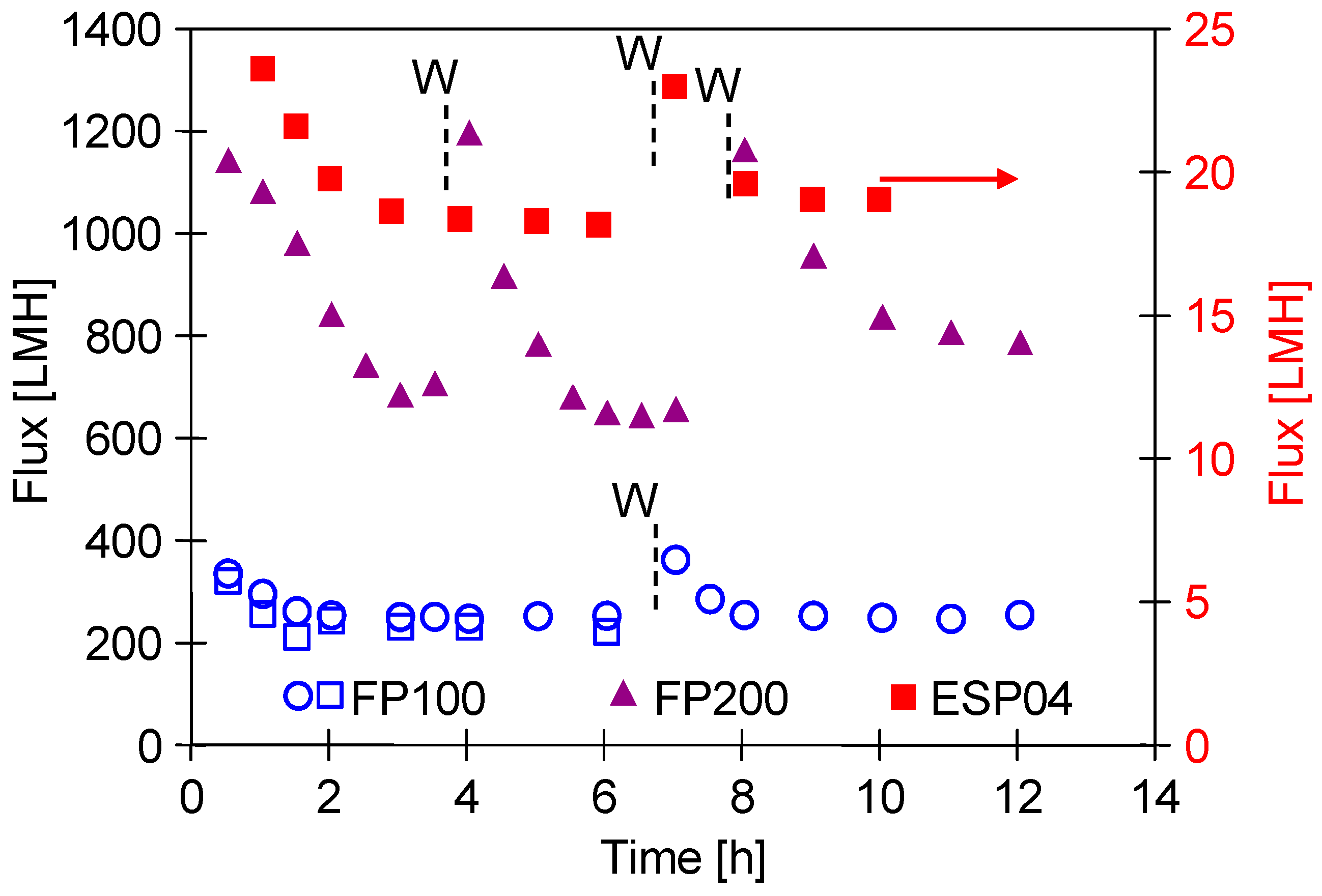
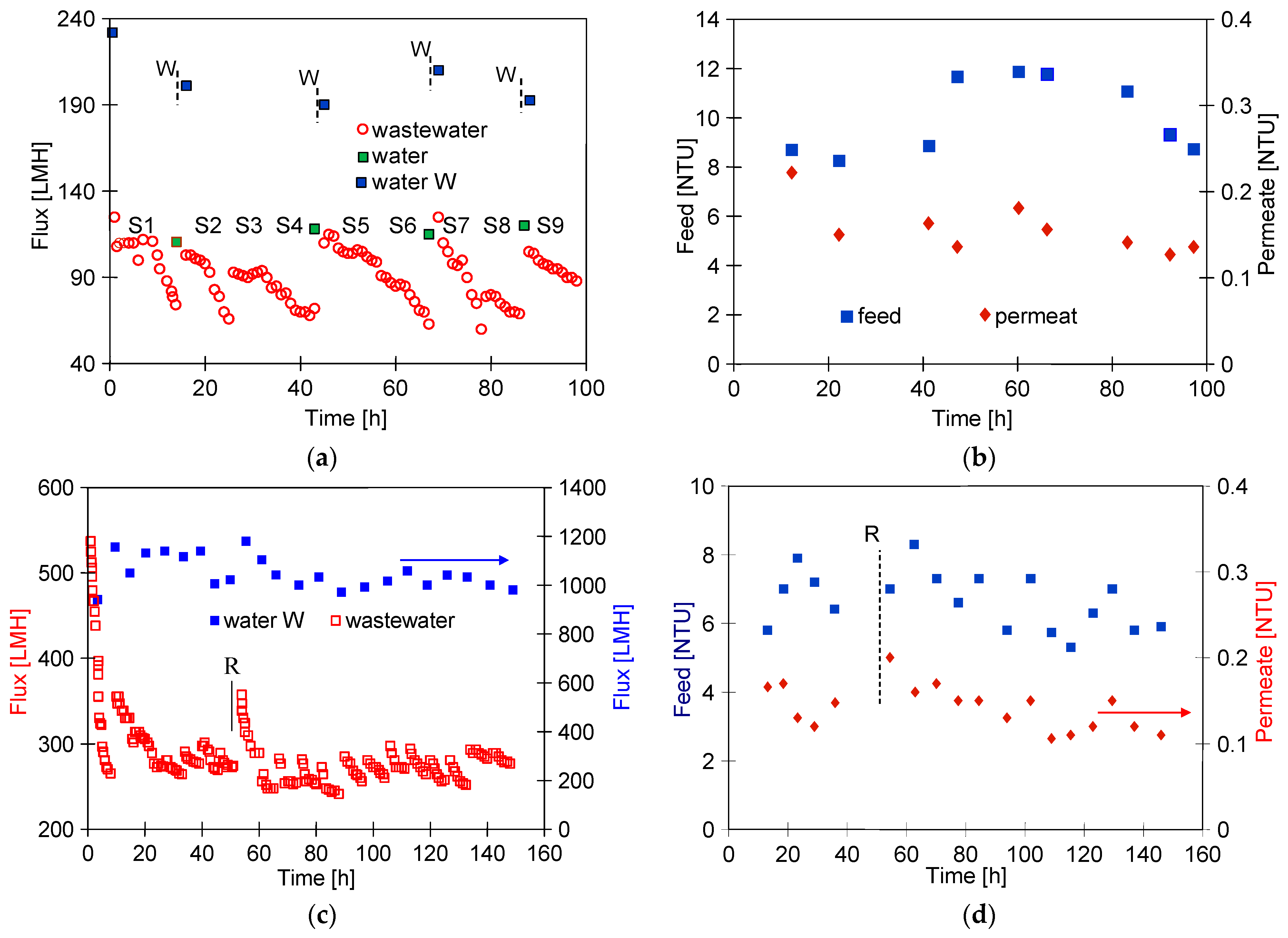

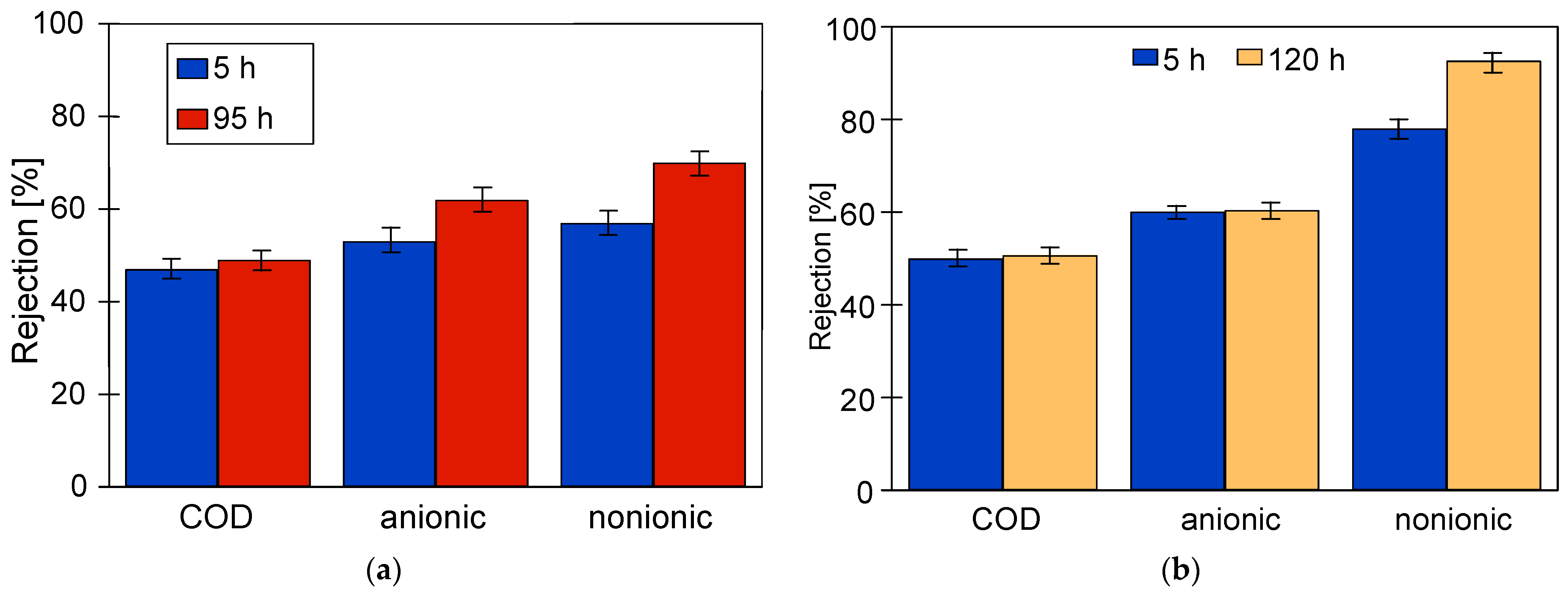

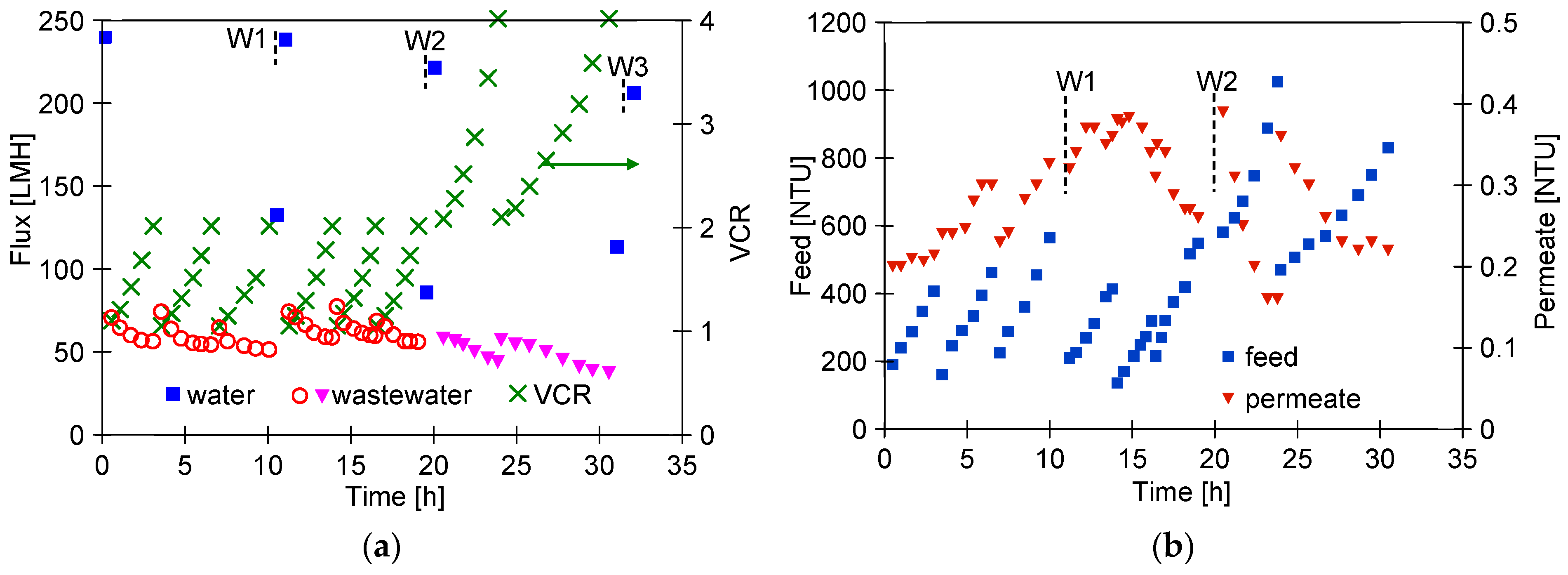
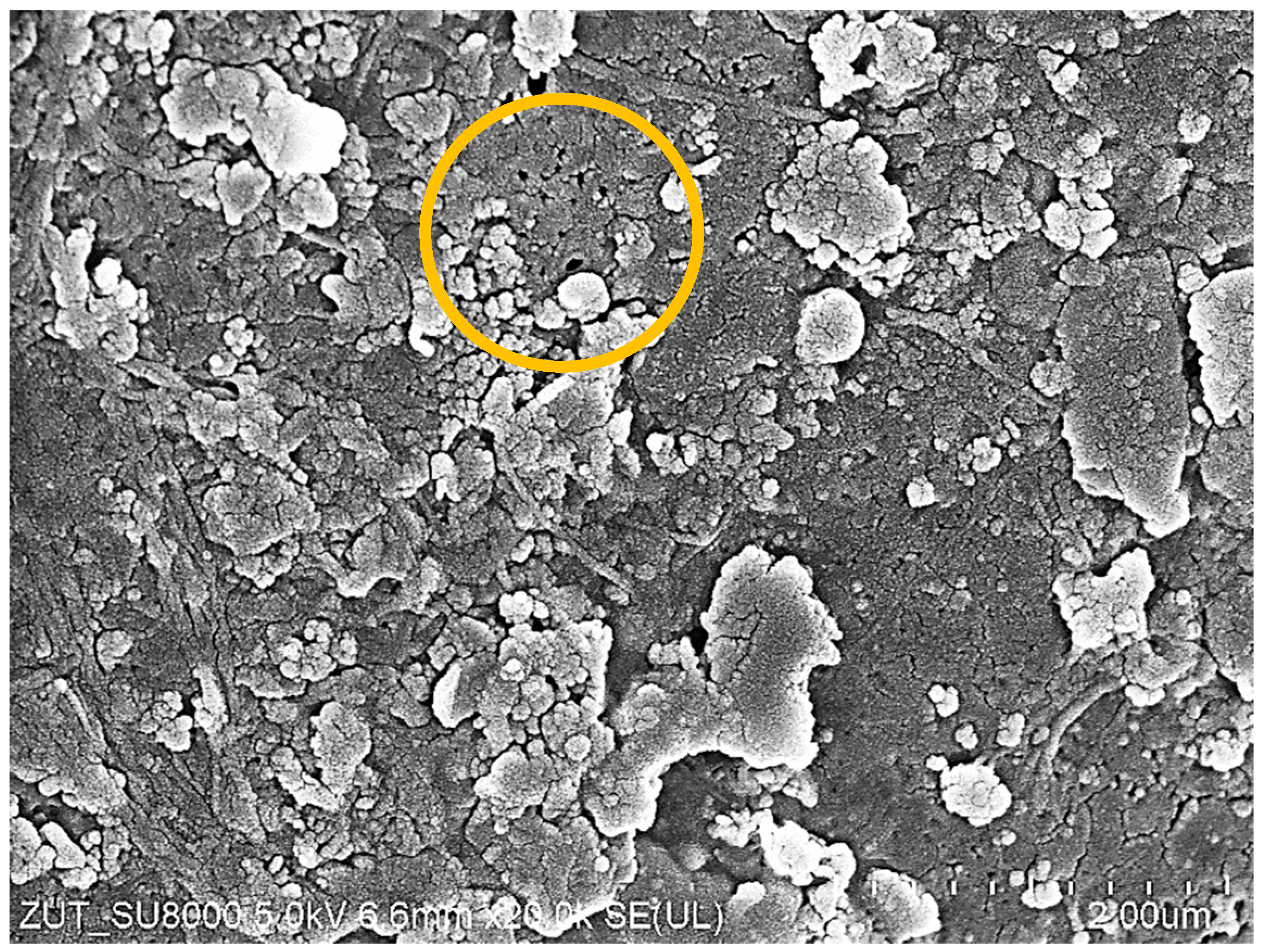
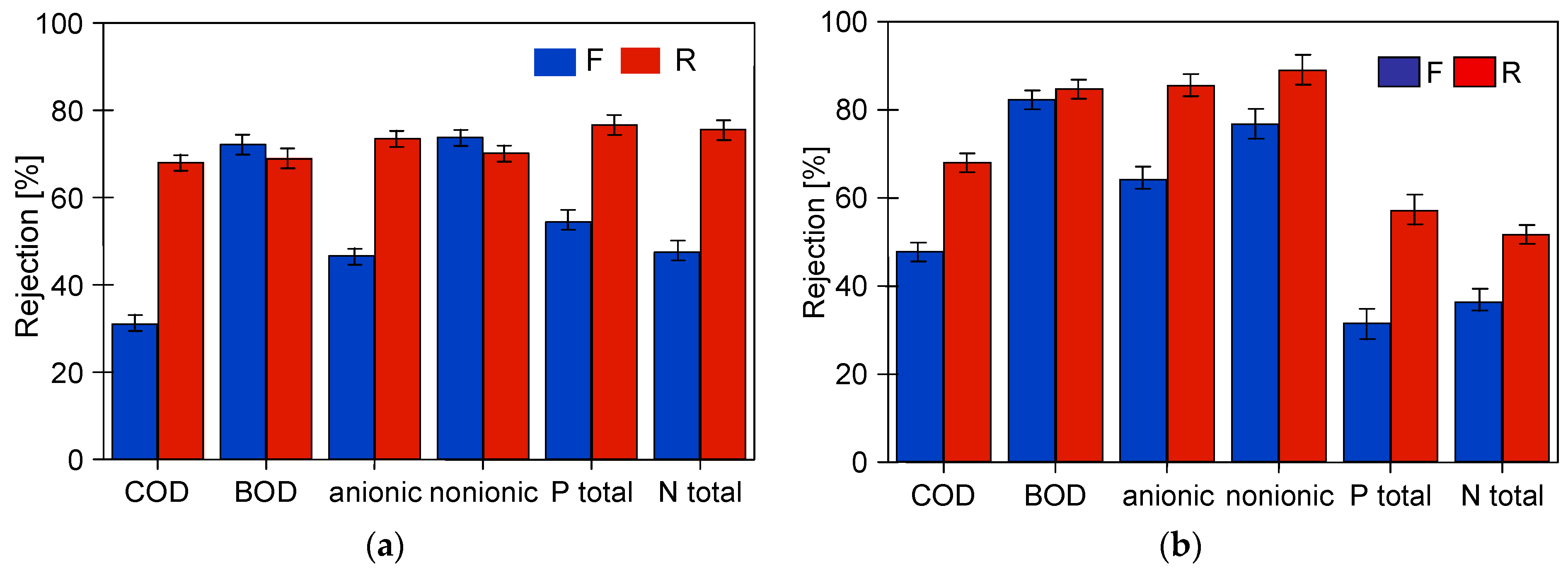


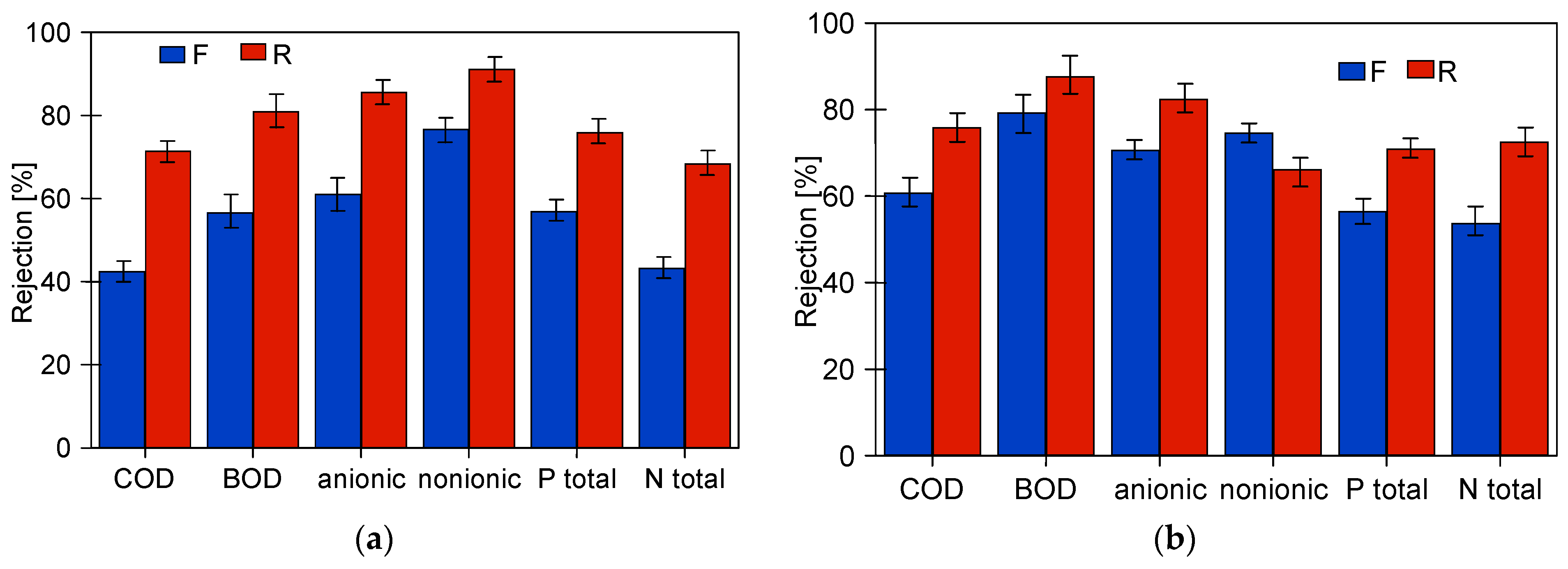

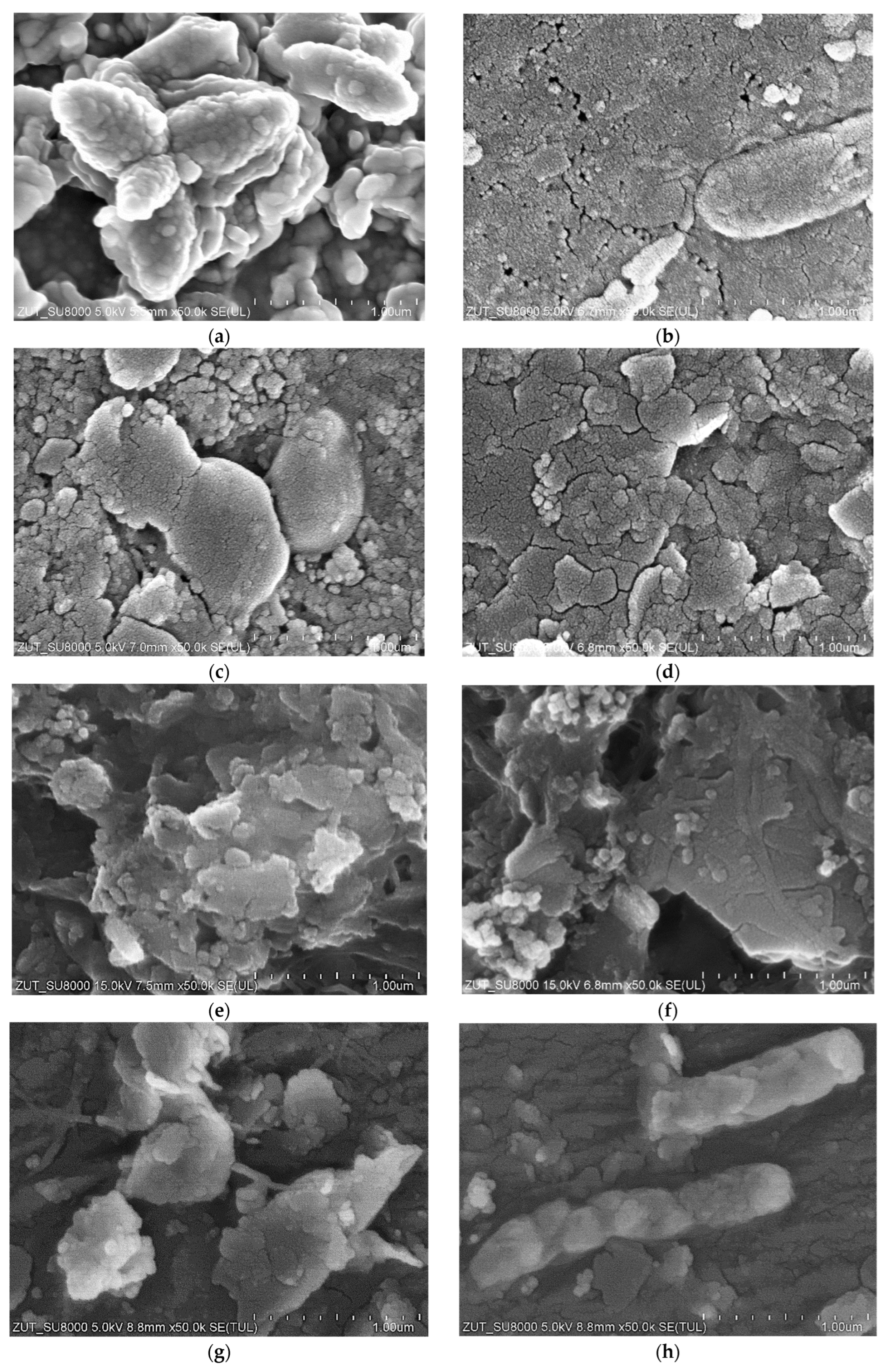
| Parameter | FP100 | FP200 | ESP04 |
|---|---|---|---|
| material | PVDF | PVDF | Modified PES |
| MWCO | 100 kDa | 200 kDa | 4 kDa |
| diameter [mm] | 12.5 | 12.5 | 12.5 |
| pH range | 1.5–12 | 1.5–12 | 1–14 |
| max TMP [MPa] | 1 | 1 | 3 |
| max T [K] | 353 | 353 | 338 |
| Parameter | WW 1 | WW1-F 1 | WW 2 | WW2-F 1 | WW 3 | WW3-F 1 |
|---|---|---|---|---|---|---|
| COD [mg/L] | 1050 | 800 | 962 | 695 | 1120 | 680 |
| BOD [mg/L] | 370 a | 324 | 195 | 38 | 260 | 75 |
| anionic [mg/L] | 135 | 133 | 99.2 | 56 | 106 | 71 |
| nonionic [mg/L] | 15.3 | 6.9 | 10.4 | 4.1 | 13.5 | 6.1 |
| total P [mg/L] | 14.5 | 12.9 | 7.6 | 7.4 | 13.8 | 12.1 |
| total N [mg/L] | 12.6 | 7.2 | 7.5 | 5.1 | 17.8 | 7.3 |
| TSS [mg/L] | 365 | - | 220 | - | 242 | - |
| turbidity [NTU] | 155 | 42 | 190 | 56 | 179 | 60 |
| Element | FP100-1 | FP100-1W | FP100-2 | FP100-2W | ESP04-3 | ESP04-3W |
|---|---|---|---|---|---|---|
| C | 29.60 | 33.19 | 28.72 | 22.78 | 50.26 | 50.24 |
| F | 60.61 | 66.45 | 10.32 | 47.24 | - | - |
| O | 9.0 | - | 45.15 | 23.69 | 42.11 | 42.71 |
| Fe | 0.34 | - | 0.92 | 0.53 | 0.08 | - |
| Al | 0.24 | 0.21 | 2.91 | 1.81 | 0.24 | 0.03 |
| Si | 0.21 | 0.15 | 6.15 | 2.85 | 0.56 | 0.21 |
| Mg | - | - | 0.52 | 0.37 | - | - |
| P | - | - | 0.99 | - | - | |
| S | - | - | 2.25 | 0.55 | 6.75 | 6.81 |
| K | - | - | 0.26 | 0.18 | - | |
| Ca | - | - | 0.87 | - | - | |
| Zn | - | - | 0.94 | - | - |
Disclaimer/Publisher’s Note: The statements, opinions and data contained in all publications are solely those of the individual author(s) and contributor(s) and not of MDPI and/or the editor(s). MDPI and/or the editor(s) disclaim responsibility for any injury to people or property resulting from any ideas, methods, instructions or products referred to in the content. |
© 2024 by the authors. Licensee MDPI, Basel, Switzerland. This article is an open access article distributed under the terms and conditions of the Creative Commons Attribution (CC BY) license (https://creativecommons.org/licenses/by/4.0/).
Share and Cite
Woźniak, P.; Gryta, M. Application of Polymeric Tubular Ultrafiltration Membranes for Separation of Car Wash Wastewater. Membranes 2024, 14, 210. https://doi.org/10.3390/membranes14100210
Woźniak P, Gryta M. Application of Polymeric Tubular Ultrafiltration Membranes for Separation of Car Wash Wastewater. Membranes. 2024; 14(10):210. https://doi.org/10.3390/membranes14100210
Chicago/Turabian StyleWoźniak, Piotr, and Marek Gryta. 2024. "Application of Polymeric Tubular Ultrafiltration Membranes for Separation of Car Wash Wastewater" Membranes 14, no. 10: 210. https://doi.org/10.3390/membranes14100210
APA StyleWoźniak, P., & Gryta, M. (2024). Application of Polymeric Tubular Ultrafiltration Membranes for Separation of Car Wash Wastewater. Membranes, 14(10), 210. https://doi.org/10.3390/membranes14100210









